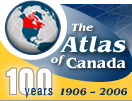
|
 |
 |
 |
 |
References and Links
 |
|
References and Links has information on the map sources, bibliographic references and links to related Web sites.
List of References and Links:
|
|
 |
 |
Map Sources |
|
The Atlas maps are composed of several layers of which there are two broad categories: thematic and base layers. Find below a description of each of the map layers. The layer source is included in the metadata.
Thematic Map Layers
- Frequency of Participation for Canoeing, Kayaking and Sailing (days/square kilometres of watershed)
- This layer presents the "frequency of participation" in powerboating as displayed by major watersheds. The units are defined as the ratio of total number of days visiting the watershed for power boating by the area of the watershed. These units are used to permit comparison between watersheds. The "Survey on the Importance of Nature to Canadians" is a nation-wide survey that assesses the social and economic value of nature-based tourism and recreation to Canadians. The data from this survey was used to display water use for swimming, canoeing and kayaking, power boating and fishing. The data is diplayed by Ocean Drainage Areas.
- Read the metadata on this layer
Base Map Layers
- Atlas of Canada Framework Layers
- Base map components are features that provide a geographic
context for the thematic data shown on Atlas of Canada maps.
These features include rivers, lakes, administrative boundaries,
populated places, roads and rail lines. All of the Atlas of
Canada base map components are available for immediate free
download in five scales and in a number of data exchange formats.
The 1:7 500 000 and the 1:1 000 000 scale data are the primary base
frameworks used for all Atlas of Canada 6th Edition online
maps. You can download Atlas of Canada data from this Web
page on GeoGratis.
|
|
 |
 |
Web Sites |
Federal Government
- Environment Canada. Freshwater Web Site
- This web site gives access to the nature of water, water policy and legislation, the management of water, water and culture, and informational resources and services.
- Environment Canada. Meteorological Service of Canada. Water Survey of Canada
- The Water Survey of Canada is the national agency responsible for the collection, interpretation and dissemination of standardized water resource data and information in Canada.
- Environment Canada. Ontario Region. Great Lakes Water Quality Agreement
- This web site gives all the aspects and the history of the Great Lakes Water Quality Agreement.
- Environment Canada. Ontario Region. Our Great Lakes
- This web site is an information resource that provides an index of Environment Canada's Great Lakes programs, publications and databases, and is a window to other environmental networks.
- Environment Canada. Quebec Region. The St. Lawrence Centre
- The St. Lawrence Centre studies the ecosystems of the St. Lawrence River and conduct research programs with the aim of better understanding how these ecosystems function, and maintaining knowledge of the St. Lawrence River up to date.
- Environment Canada. Survey on the Importance of Nature to Canadians
- The Survey on the Importance of Nature to Canadians, which assesses the social and economic value of nature-related activities to Canadians, drew on a nationwide partnership of 16 federal, provincial, and territorial agencies.
- Environment Canada. The National Water Research Institute
- The National Water Research Institute (NWRI) is Canada's largest freshwater research establishment. NWRI conducts a comprehensive program of research and development in the aquatic sciences, in partnership with the Canadian and international science communities.
- Fisheries and Oceans Canada. Canadian Hydrographic Service (CHS)
- The CHS is responsible for charting Canada's 243,792 kilometres of coastline (the longest of any country in the world) and 6.55 million square kilometres of continental shelf and territorial waters (the second largest in the world) and an extensive system of inland waterways.
Other
- University of Guelph. Canada’s Aquatic Environments
- This site, at the University of Guelph, gives information on lakes, rivers, wetland regions and aquatic animals and plants.
International Government
- United Nations Educational, Scientific and Cultural Organization. International Hydrological Programme
- This particular site outlines World Water Resources and their use, a joint project and database which disseminates a comprehensive data set on global surface water resources, and water use for domestic, agricultural and industrial purposes.
Inter-agency
- International Joint Commission
- The International Joint Commission is an independent binational organization established by the Boundary Waters Treaty of 1909. Its purpose is to help prevent and resolve disputes relating to the use and quality of boundary waters and to advise Canada and the United States on related questions.
|
|
|
|
